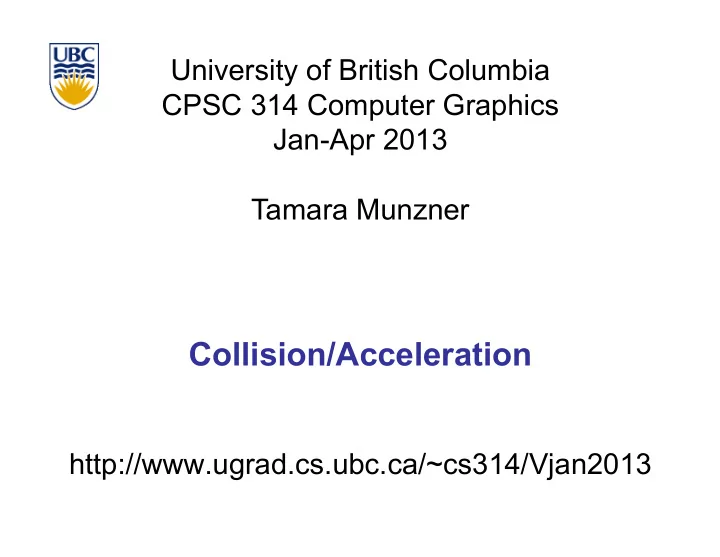

University of British Columbia CPSC 314 Computer Graphics Jan-Apr 2013 Tamara Munzner Collision/Acceleration http://www.ugrad.cs.ubc.ca/~cs314/Vjan2013
Reading for This Module • FCG Sect 12.3 Spatial Data Structures 2
Collision/Acceleration 3
Collision Detection • do objects collide/intersect? • static, dynamic • picking is simple special case of general collision detection problem • check if ray cast from cursor position collides with any object in scene • simple shooting • projectile arrives instantly, zero travel time • better: projectile and target move over time • see if collides with object during trajectory 4
Collision Detection Applications • determining if player hit wall/floor/obstacle • terrain following (floor), maze games (walls) • stop them walking through it • determining if projectile has hit target • determining if player has hit target • punch/kick (desired), car crash (not desired) • detecting points at which behavior should change • car in the air returning to the ground • cleaning up animation • making sure a motion-captured character’s feet do not pass through the floor • simulating motion • physics, or cloth, or something else 5
From Simple to Complex • boundary check • perimeter of world vs. viewpoint or objects • 2D/3D absolute coordinates for bounds • simple point in space for viewpoint/objects • set of fixed barriers • walls in maze game • 2D/3D absolute coordinate system • set of moveable objects • one object against set of items • missile vs. several tanks • multiple objects against each other • punching game: arms and legs of players • room of bouncing balls 6
Naive General Collision Detection • for each object i containing polygons p • test for intersection with object j containing polygons q • for polyhedral objects, test if object i penetrates surface of j • test if vertices of i straddle polygon q of j • if straddle, then test intersection of polygon q with polygon p of object i • very expensive! O(n 2 ) 7
Fundamental Design Principles • fast simple tests first , eliminate many potential collisions • test bounding volumes before testing individual triangles • exploit locality , eliminate many potential collisions • use cell structures to avoid considering distant objects • use as much information as possible about geometry • spheres have special properties that speed collision testing • exploit coherence between successive tests • things don’t typically change much between two frames 8
Example: Player-Wall Collisions • first person games must prevent the player from walking through walls and other obstacles • most general case: player and walls are polygonal meshes • each frame, player moves along path not known in advance • assume piecewise linear: straight steps on each frame • assume player’s motion could be fast 9
Stupid Algorithm • on each step, do a general mesh-to-mesh intersection test to find out if the player intersects the wall • if they do, refuse to allow the player to move • problems with this approach? how can we improve: • in response? • in speed? 10
Collision Response • frustrating to just stop • for player motions, often best thing to do is move player tangentially to obstacle • do recursively to ensure all collisions caught • find time and place of collision • adjust velocity of player • repeat with new velocity, start time, start position (reduced time interval) • handling multiple contacts at same time • find a direction that is tangential to all contacts 11
Accelerating Collision Detection • two kinds of approaches (many others also) • collision proxies / bounding volumes • spatial data structures to localize • used for both 2D and 3D • used to accelerate many things, not just collision detection • raytracing • culling geometry before using standard rendering pipeline 12
Collision Proxies • proxy: something that takes place of real object • cheaper than general mesh-mesh intersections • collision proxy (bounding volume) is piece of geometry used to represent complex object for purposes of finding collision • if proxy collides, object is said to collide • collision points mapped back onto original object • good proxy: cheap to compute collisions for, tight fit to the real geometry • common proxies: sphere, cylinder, box, ellipsoid • consider: fat player, thin player, rocket, car … 13
Trade-off in Choosing Proxies Sphere AABB OBB 6-dop Convex Hull increasing complexity & tightness of fit decreasing cost of (overlap tests + proxy update) • AABB: axis aligned bounding box • OBB: oriented bounding box, arbitrary alignment • k-dops – shapes bounded by planes at fixed orientations • discrete orientation polytope 14
Pair Reduction • want proxy for any moving object requiring collision detection • before pair of objects tested in any detail, quickly test if proxies intersect • when lots of moving objects, even this quick bounding sphere test can take too long: N 2 times if there are N objects • reducing this N 2 problem is called pair reduction • pair testing isn ’ t a big issue until N>50 or so … 15
Spatial Data Structures • can only hit something that is close • spatial data structures tell you what is close to object • uniform grid, octrees, kd-trees, BSP trees • bounding volume hierarchies • OBB trees • for player-wall problem, typically use same spatial data structure as for rendering • BSP trees most common 16
Uniform Grids • axis-aligned • divide space uniformly 17
Quadtrees/Octrees • axis-aligned • subdivide until no points in cell 18
KD Trees • axis-aligned • subdivide in alternating dimensions 19
BSP Trees • planes at arbitrary orientation 20
Bounding Volume Hierarchies 21
OBB Trees 22
Related Reading • Real-Time Rendering • Tomas Moller and Eric Haines • on reserve in CICSR reading room 23
Acknowledgement • slides borrow heavily from • Stephen Chenney, (UWisc CS679) • http://www.cs.wisc.edu/~schenney/courses/cs679-f2003/lectures/cs679-22.ppt • slides borrow lightly from • Steve Rotenberg, (UCSD CSE169) http://graphics.ucsd.edu/courses/cse169_w05/CSE169_17.ppt • 24
Recommend
More recommend